Seattle Center festivals, exhibits make a World’s Fair of fun
When organizers of the Seattle World’s Fair looked down on the fairgrounds from the top of the Space Needle on April 21, 1962, they saw something shocking. Instead of the crowds they’d hoped for on opening day, there was just a trickle of people and empty parking lots. “Everybody thought ‘My God, what have we done?’ ” recalls Don Foster, the fair’s director of exhibits.
In a KCTS 9 television documentary, Foster and other old-timers tell how that first view provoked a fear that the fair would flop. But it turned out that people were simply staying away on opening day to avoid anticipated crowds. In October, at the end of the fair’s six-month run, over 10 million people had visited. Many now see the fair as a defining moment in Seattle’s history.
I recalled this anecdote as I stood on the observation deck of the Space Needle on June 24, 2012. Chuckling, I wondered what the organizers 50 years ago would have made of my aerial view now. Peering down at Seattle Center, I saw tens of thousands of people flooding the 30-hectare area for Seattle PrideFest. A dull roar of music, cheering, and clapping drifted up. Crowds lined 4th Avenue as drag queens, scantily clad dancers, and floats paraded towards the former fairgrounds—along with a massive rainbow-coloured flag stretched taut horizontally by the dozens of people who carried it proudly down the street.
A lot has changed in 50 years. Yet Seattle Center is still a site for public celebration, whether it’s gay pride or annual music and arts festivals like Bumbershoot. And until October 21—the day the 1962 World’s Fair ended—there are a host of other arts, cultural, and educational events as part of the Next Fifty programming.
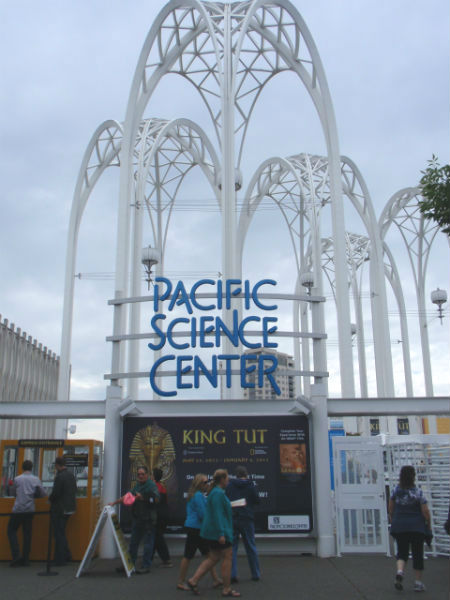
Pacific Science Center was built for the 1962 World's Fair. Carolyn Ali photo.
Take away the festivities and there’s still plenty to do at Seattle Center. It’s home to Seattle Storm women’s basketball games and concerts at KeyArena, Pacific Northwest Ballet, and the Seattle Repertory Theatre. Besides the Space Needle and the Pacific Science Center—both built for the 1962 fair—there’s the EMP Museum (which debuted as Experience Music Project in 2000 and now covers music, sci-fi and pop culture) and the new Chihuly Garden and Glass exhibit.
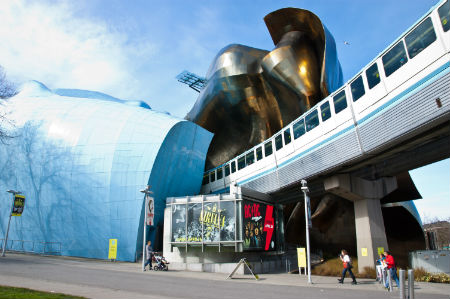
The Monorail runs from downtown through the EMP Museum, designed by Frank Gehry.
I visited Seattle Center to check out the latest happenings and found there was so much to do that I didn’t leave the area for two full days. My hotel, the Maxwell, was just across the street from the complex, with a view of the Space Needle, so it was a convenient place to take a breather between sights.
After getting the lay of the land from the Space Needle’s 158-metre-high observation deck, I rode the elevator down to see the wildly colourful glass art of Dale Chihuly, which I had glimpsed on high. Located in the former Fun Forest site south of the monorail station, Chihuly Garden and Glass opened in May.
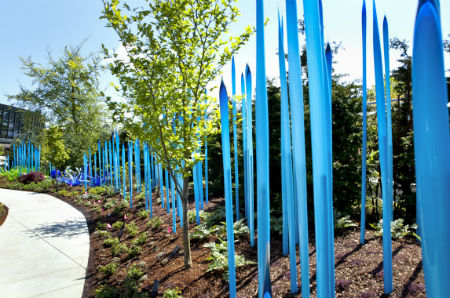
Glass reeds blend with nature at the Chihuly Garden and Glass exhibit.
Chihuly is a Washington-state native who revolutionized and popularized the studio glass movement. He’s known for his vibrantly whimsical installations, such as the glass-blossom-covered ceiling in the lobby of the Bellagio Hotel in Las Vegas. This Seattle Center exhibit is the most comprehensive collection of his art ever assembled and there’s no end date to it, as the space is on a long-term lease.
The indoor-outdoor show is a candy store for a Chihuly fan like me. Walking through the hall, I marvelled at the glass ceiling covered in seashell-like Persian sea forms, a boat filled with Japanese glass floats, and a room hung with wildly colourful chandeliers. Outside, the airy conservatory houses a gorgeous 30-metre-long orange sculpture suspended from the ceiling. But it’s the garden that really thrills: it’s amazing how the sculptures both contrast and harmonize with the natural landscape. The scene is always changing as the glass filters the daylight and is illuminated at night.
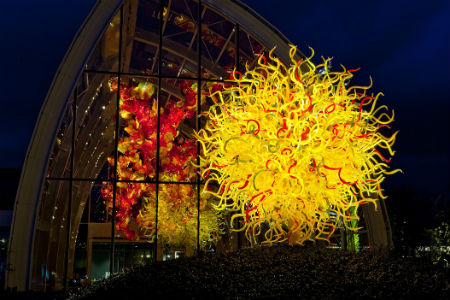
The Chihuly Garden and Glass exhibit takes on a new look at night.
A five-minute walk away is the EMP Museum, where there are so many exhibits to choose from it’s hard to decide which way to go first. This being Seattle, it’s only appropriate to view the Kurt Cobain and Nirvana exhibit (on until next April), but there’s also an AC/DC exhibit on to September 24 and an AVATAR (the movie) exhibit, which runs until September 3.
After playing happily with the mixing console in the EMP’s interactive sound lab, I surprised myself by spending the bulk of my time at the exhibit called “Can’t Look Away: The Lure of Horror Film”. I never watch horror movies—The Silence of the Lambs still haunts me—but what’s on display here is fascinating. Sure, there’s the hacksaw from Saw and Jason Voorhees’s mask and machete from Friday the 13th, but they’re behind glass and the room isn’t chamber-of-horrors scary. Instead, some of the displays are downright enlightening as people involved in the horror business share their perspectives on the industry.
Take director Eli Roth, for example. Despite being behind Hostel, he comes across as a very likable guy in a video clip on why people love horror movies. “In our daily lives, we are not allowed to be afraid,” he says, yet we’re all constantly thinking about death. “When you watch a horror movie, you are socially given permission to be terrified,” he enthuses. “It’s this great, communal feeling.”
Pondering this, I headed over to the Pacific Science Center to see the treasures of one of the most celebrated dead guys of all time. “Tutankhamun: The Golden King and the Great Pharaohs” is a blockbuster show with over 100 objects from King Tut’s tomb, as well as other artifacts; it runs until January 6, 2013. While the exhibit doesn’t contain King Tut’s iconic death mask (that’s a close-up of his forearm-sized canopic coffinette you see in the promotional posters), it’s still very impressive.
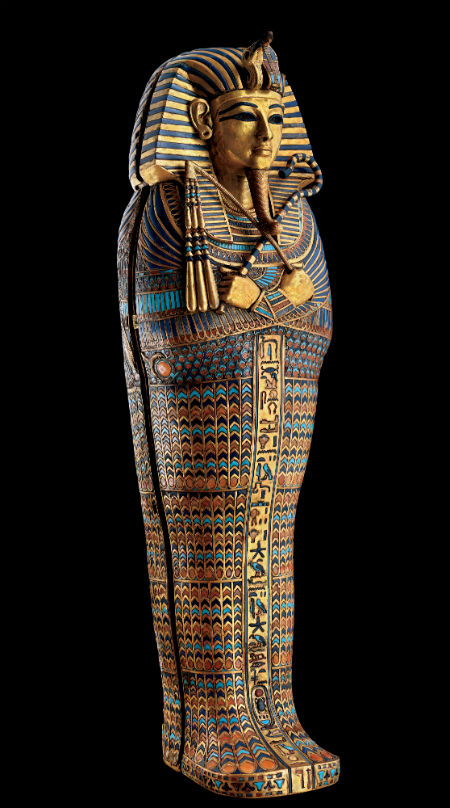
One of four miniature coffins that held the internal organs of King Tut, this canopic coffinette is on display at the Pacific Science Center.
The Tut exhibit guides visitors through room by room in the same order British explorer Howard Carter discovered the tomb’s chambers in 1922. Archival photo murals give the objects under glass delicious context. I found all the solid gold delightful, including a set of finger- and toe-shaped jewellery meant to protect the mummy’s digits in the afterlife. My favourite item was the shiny T-strapped real-gold sandals that covered Tut’s feet when the mummy was unearthed. The design is so timeless that any fashionista would be thrilled to get his or her feet in them.
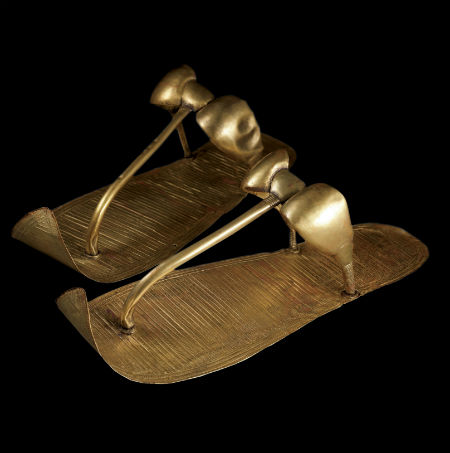
King Tut's golden sandals were created specfically for the afterlife.
Outside at Seattle PrideFest, there were plenty of rubber flip-flops being worn by people making creative, rainbow-themed fashion statements. There was also no shortage of campaigners handing out LGBT for Obama buttons and urging people to vote in a referendum this November to ensure that the same-sex marriage law on hold in Washington state takes effect and is not repealed.
It was a spirited scene that visitors to the Seattle World’s Fair probably couldn’t have imagined 50 years ago. In the next 50, who knows what will happen here?
Access: The key to avoiding lines at Seattle Center is buying your tickets online in advance. This is particularly important for the Pacific Science Center’s King Tut exhibit, which can be sold out for hours during peak periods. A CityPASS allows entrance and bypassed queues to a number of attractions for $69, including the Space Needle, the EMP Museum, and the Pacific Science Center (but not the Tut exhibit; there’s no fast-track queue). Find Garden and Glass exhibit tickets on the Chihuly website. For info on Seattle World’s Fair events and celebrations, see the Next Fifty. Bumbershoot takes place September 1 to 3; see the Bumbershoot website. The writer toured as a guest of Seattle’s Convention and Visitors Bureau and stayed at the Maxwell Hotel Seattle; for tourist info, see Visit Seattle.
Follow Carolyn Ali on Twitter at twitter.com/carolynali
.














Comments